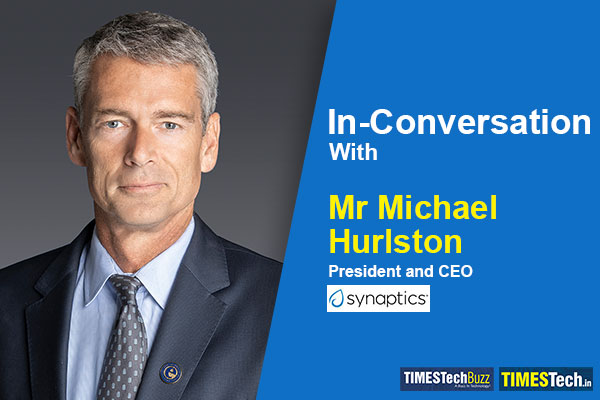India is still in the process of developing its capabilities in what we consider the most crucial aspect of the electronics hardware segment – semiconductor manufacturing. Semiconductor production entails greater complexity, expense, and resource-intensive operations. Achieving the scale and success seen in chip manufacturing regions like Taiwan, Korea, and the US is a lengthy journey underlines Michael Hurlston, CEO, Synaptics. In this exclusive interview with Times Tech, Michael shares his perspectives on the growth of IoT and Industry 4.0 in India, the company’s strategies to promote talent development within the country and also shares his vantage on the Indian government’s active efforts to promote the semiconductor ecosystem.
Times Tech: How does your company plan to contribute to the increasing momentum in the electronics/IT hardware industry in the country?
Mr. Michael Hurlston: India’s transition towards a manufacturing-oriented economy, particularly in the electronics sector, is indisputable. The country has seen remarkable growth in system-level and end-product manufacturing within the electronics value chain. We commend the Indian government for its efforts in attracting such activities and investments. However, India is still in the process of developing its capabilities in what we consider the most crucial aspect of the electronics hardware segment – semiconductor manufacturing. Semiconductor production entails greater complexity, expense, and resource-intensive operations. Achieving the scale and success seen in chip manufacturing regions like Taiwan, Korea, and the US is a lengthy journey.
The ecosystem surrounding semiconductor manufacturing, including testing and packaging, is also fiercely competitive. Emerging economies like Vietnam, Southeast Asia, and Mexico are actively striving to establish themselves in this field. We have recently entered into an agreement with a company to conduct some of our testing and packaging operations in India, indicating progress in this area.
However, our primary focus, especially in electronics and semiconductors, is on India’s strength as a developer of intellectual property and chip designs. India’s position as a hub for creating innovative designs and intellectual assets that eventually undergo manufacturing and integration into everyday end products makes it an attractive destination for investment and establishing a robust presence.
Times Tech: What are your perspectives on the growth of IoT and Industry 4.0 in India? Furthermore, could you elaborate on Synaptics’ offerings in the IoT and wireless connectivity domain?
Mr. Michael Hurlston: We recognize the significant growth potential of IoT and Industry 4.0 in India. As these technologies continue to advance and shape various industries, we see tremendous opportunities for their implementation in India’s rapidly evolving digital landscape. In the domain of IoT and wireless connectivity, Synaptics offers a range of solutions that cater to the growing demands of connected devices. Our expertise lies in providing cutting-edge technologies and platforms to enable seamless and secure wireless connectivity in IoT applications.
Our key offerings include:
- Wireless Connectivity Solutions: Synaptics offers a comprehensive suite of wireless connectivity solutions, including Wi-Fi, Bluetooth, ULE, and Zigbee, that are Matter compliant and facilitate seamless, interoperable communication and are designed to meet the increasing connectivity demands of smart homes, industrial automation, and other IoT applications.
- Edge Computing and AI: With the rise of edge computing and AI in IoT, Synaptics provides powerful edge processing platforms that enable real-time analytics and intelligence at the edge of the network. These platforms empower IoT devices to perform complex tasks locally, reducing latency and enhancing privacy and security.
- Security Solutions: Our solutions encompass hardware-based security features, secure boot, encryption, authentication, and secure communication protocols, ensuring the integrity and confidentiality of IoT data.
- Sensor Solutions: Synaptics specializes in developing advanced sensor technologies for IoT applications. Our sensor offerings include integrated touch sensing and display solutions, biometric sensors, and advanced touch sensors that enable accurate data capture, intuitive user interfaces, and enhanced user experiences in IoT devices.
Furthermore, as the IoT landscape continues to evolve, Synaptics remains committed to driving innovation and collaborating with industry partners to deliver tailored solutions for specific verticals and use cases. We strive to enable India’s digital transformation by leveraging IoT and wireless connectivity to create smarter, connected ecosystems across industries such as smart homes, smart cities, healthcare, automotive, and industrial automation.
Times Tech: What measures are currently being taken to expand your team and promote talent development within the country, and how do you anticipate these actions impacting Synaptics’ future in India?
Mr. Michael Hurlston: As I mentioned earlier, under our strong and dynamic local leadership, India has become our fastest-expanding site, surpassing our other locations by a significant margin. We are committed to further expanding our workforce here, and although our total headcount is currently around 2000, India is already our third largest design center. By the end of 2024, we anticipate that it will become our second or even our largest design center in terms of headcount.
The level of innovation happening here is astounding. Our team in India comes up with groundbreaking ideas and approaches, particularly when it comes to redesigning our core semiconductors. We are heavily investing in hiring top talent and implementing programs to engage with university students, including internships and initiatives for new college graduates. Our aim is to attract and nurture the best talent at an early stage of their careers.
We are determined to seize the opportunity to tap into the remarkable talent pool, innovate relentlessly, and ensure that India remains at the forefront of our strategic expansion plans.
Times Tech: Do you believe that the Indian government’s active efforts to promote the semiconductor ecosystem will positively impact your operations in India?
Mr. Michael Hurlston: When examining the semiconductor manufacturing process, stage two involves the involvement of major wafer houses and packaging facilities. There has been talk of developing this aspect in India, but no concrete action has been taken yet. Establishing state-of-the-art semiconductor manufacturing facilities in India presents challenges due to infrastructure and power requirements.
However, the crucial aspect lies in stage one, which focuses on intellectual property (IP) development and the design end of semiconductors. India has emerged as a global leader in semiconductor IP development, with multinational companies leveraging Indian design centers to create IP.
India possesses a strong advantage in capitalizing on the global opportunities arising in the semiconductor industry, particularly by leveraging its expertise in design and IP stages. The country boasts one of the finest education systems globally, a proficient English-speaking workforce, and a commendable standing in STEM-related education and training. These factors collectively position India as an enticing and compelling region for expanding its involvement in the global electronics and semiconductor sectors, right from the core foundation of the value chain.















